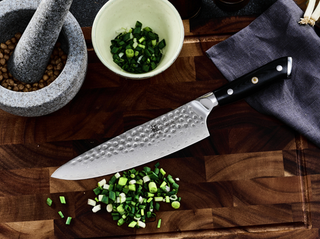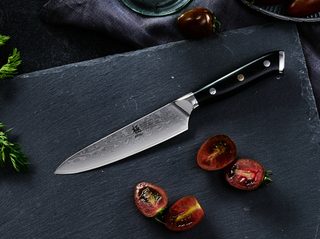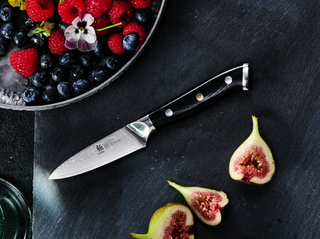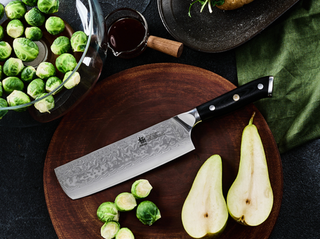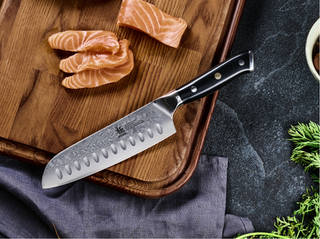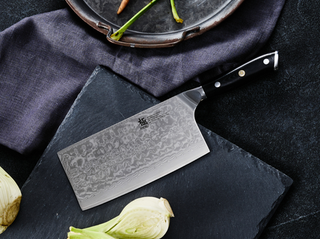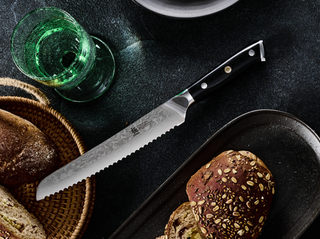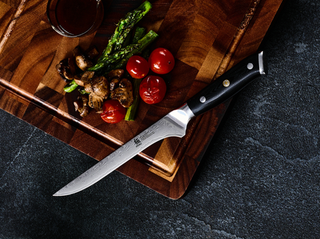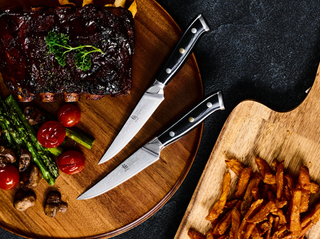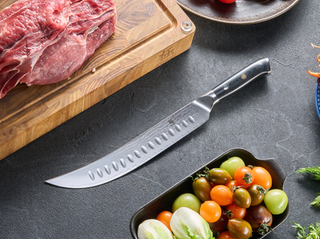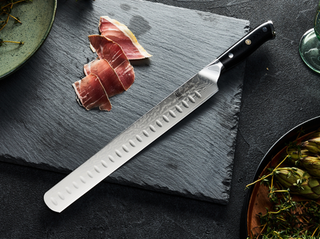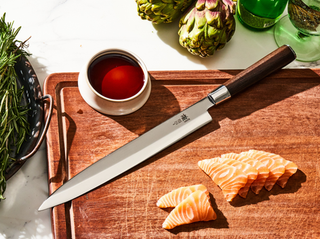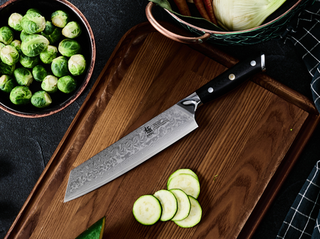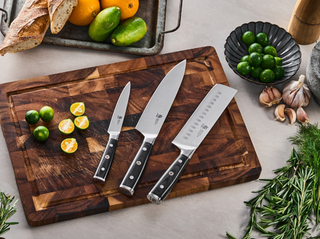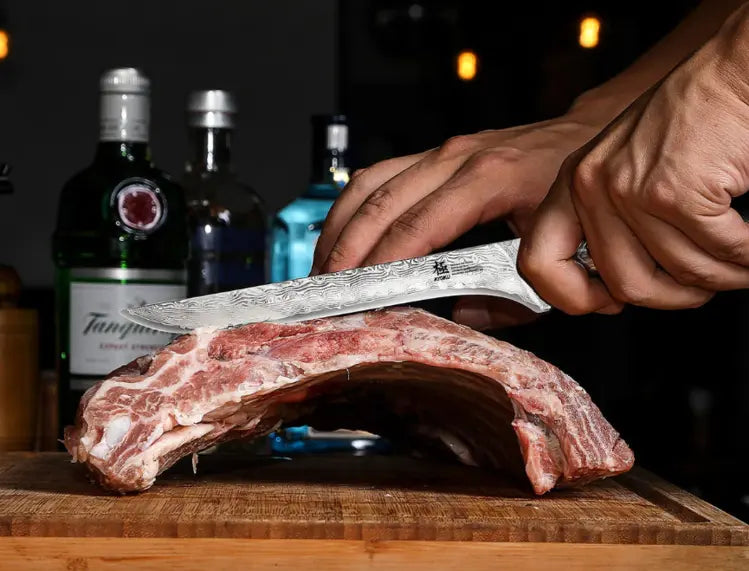Most home cooks reach for their chef's knife for every cutting task – until they try breaking down their first whole chicken or filleting a fish. That's when they discover why professional kitchens always keep two specialized blades on hand: the boning knife and the fillet knife. While comparing a boning knife vs fillet knife might seem straightforward, using the wrong one can mean the difference between clean, professional cuts and wasted meat.
The Essential Differences Between Boning and Fillet Knives
A boning knife combines precision with strength, featuring a relatively stiff blade that typically measures between 5-7 inches.
-
This design allows you to maintain control while working around bones and through joints.
-
The blade's stiffness of the boning knife is crucial when you need to apply pressure to separate meat from bone or cut through tougher connective tissues.
In contrast, a fillet knife emphasizes flexibility in its design. Its longer blade, usually 7-9 inches, allows for smooth, uninterrupted cuts when filleting fish.
-
This is essential for following the natural curves of a fish's body and separating flesh from skin without wasting any meat.
What is a Boning Knife Used For?

A boning knife has one main job: to help you separate meat from bone. Its sharp, pointed tip is perfect for making the first cut exactly where you need it. Think of it like a precision tool - you can get into tight spots around bones and joints without damaging the meat.
The blade is slightly flexible, but still firm enough to handle tough meat. This balance is important. Too stiff, and you can't work around curved bones. Too flexible, and you'll struggle with tougher cuts.
Ask any chef about their favorite task for a boning knife, and they'll likely mention chicken. The knife excels at tasks like:
-
Removing chicken breasts cleanly from the bone
-
Working around wing joints
-
Separating thigh meat from leg bones
This precision matters even more when you're working with expensive meats. A good boning knife helps you get every usable bit of meat without waste.
What is a Fillet Knife Used For?

A fillet knife is all about working with fish. Its blade is much more flexible than a boning knife, and for good reason. Fish have delicate meat and lots of small bones. You need a knife that can follow the natural curves of the fish.
The longer blade helps you make smooth, unbroken cuts when filleting. This is crucial because stopping and starting while cutting fish often leads to jagged, messy edges in your fillets.
Here's why the design works so well:
-
The flexible blade follows the curve of the fish's body
-
The longer length lets you cut in one smooth motion
-
The thin blade slips easily between skin and flesh
Think of it like this: if a boning knife is like a precision scalpel, a fillet knife is more like an artist's brush - flowing and flexible to create clean, smooth results.
How to Choose Between a Boning and Fillet Knife
Let's make this choice simple. Think about what you cook most often in your kitchen.
Do you often cook chicken, pork, or beef? A boning knife is your best choice. It's stiff enough to work around bones and through joints, making it perfect for tasks like breaking down a whole chicken or trimming a roast.
Are you a fish enthusiast? Go for a fillet knife. Its flexible blade is designed specifically for fish preparation. You'll find it much easier to remove skin, create perfect fillets, and work around those tiny pin bones.
How to Use Boning Knife and Fillet Knife Properly
Using a boning knife is like following a map.
-
Start by finding the spot where meat meets bone.
-
Use the knife's tip like a guide, finding the natural separation points.
-
Then let the blade follow this path, keeping firm control as you separate meat from bone.
-
This works especially well when you're removing chicken breasts or cleaning up a ribeye.
Fillet knife technique is more like painting a smooth stroke.
-
Use light, long motions instead of pressing hard.
-
When you're removing fish skin, keep the blade at a low angle and let it glide between the flesh and skin.
-
The flexible blade does most of the work for you.
What Professional Chefs Know About These Knives
Walk into any professional kitchen and you'll see both knives in use. Here's why: while you could use a boning knife to fillet fish, it's like trying to paint with a pencil – it works, but you're making the job harder than it needs to be.
Japanese knife makers take this specialization even further. Take their boning knife, the honesuki, for example. They make it with harder steel that keeps its edge longer. But this also means the blade is stiffer – perfect for precise cuts around chicken bones, but not ideal for the flowing cuts needed in fish preparation.
Best Boning Knives for Different Needs

After understanding how to choose between a boning knife vs fillet knife, let's look at two professional-grade options that excel in different ways.
For Everyday Precision: Kyoku Samurai Series 6.5" Boning Knife
This knife strikes an excellent balance between flexibility and control. The 56-58 HRC Japanese carbon steel gives you just enough flex for detailed work while maintaining the firmness needed for tough cuts. The 13-15 degree edge angle makes clean separation of meat from bone feel almost effortless, especially when working with poultry or pork. What makes this knife particularly valuable for home cooks is its versatility – it handles both basic deboning tasks and more delicate trimming work with equal precision.
For Professional-Level Performance: Kyoku Damascus 7" Boning Knife
When you're ready to step up your meat preparation game, this traditional Japanese boning knife offers exceptional control. Its VG-10 core steel, hardened to 58-60 HRC, provides the perfect balance of edge retention and durability. The ultra-sharp 8-12 degree edge angle excels at precise cuts around bones and joints. While it has a steeper learning curve than the Samurai Series, this knife rewards proper technique with unmatched precision, especially when breaking down whole chickens or working with high-end cuts of meat.
Both knives represent different approaches to the same goal. The Samurai Series offers more forgiveness and versatility for home cooks, while the Damascus Honesuki provides the exacting precision preferred by professional chefs. Either way, you're investing in a knife that will fundamentally improve your meat preparation results.
Making Your Final Choice: Boning Knife vs Fillet Knife
When deciding between a boning knife vs fillet knife, consider your cooking style and the types of proteins you prepare most often. A boning knife offers more versatility for general meat preparation, while a fillet knife excels at fish preparation. If you're just starting to build your knife collection, choose based on your most common tasks – you can always add the other knife as your needs expand.
